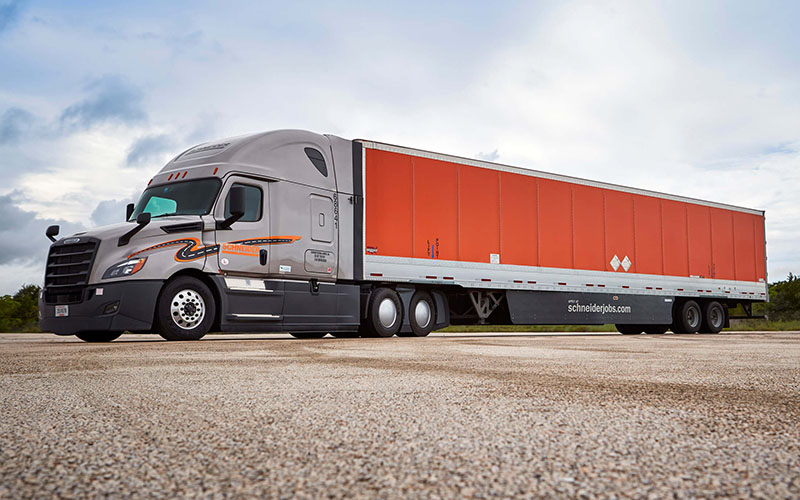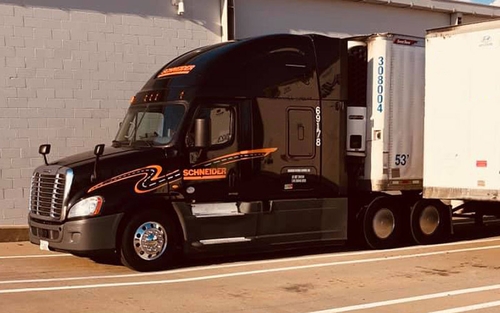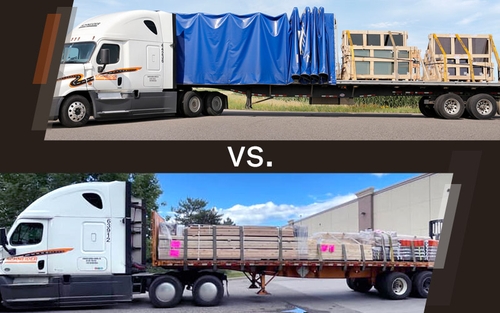Semi-truck and trailer dimensions: A guide to standards


By The Schneider Guy
Estimated reading time: 3 minutes
Semi-trucks are responsible for moving most of the country’s freight, making them an essential part of the supply chain and everyday living. While most people see them all over the nation’s highways, few take the time to consider or appreciate just how large the vehicles are.
Keep reading to find out more information about semi-truck and trailer dimensions.
How long is a semi-truck?
Combining the tractor and trailer, a standard semi-truck's length is about 70 feet long.
The length can vary considerably, though, based on a variety of factors.
1. Type of tractor.
- Day cabs are typically 20 feet long, though each manufacturer and spec can alter that.
- Sleeper cabs, which have a bed inside for drivers who haul over-the-road, are also around 20 feet in length.
2. Type of trailer.
- A standard dry van trailer is 53 feet long. It overlaps a few feet over top of the tractor, making the unit about 70 feet.
- Pup trailers are typically 28 feet in length. It is common to see two pup trailers pulled together, making for a total length of around 56 feet.
- Intermodal containers are typically 20 or 40 feet long but can also reach the standard 53 feet.
- Tanker trailers, flatbeds and a variety of other trailer types all range between 48-53 feet.
- Extendable double drops and Removable Goosenecks (RGN) are some of the longest trailers available. Both reach 80 feet long when fully extended and typically carry other vehicles and large equipment.
3. State requirements.
Companies can often get creative with the length of their equipment for specialty freight needs, but each state has different regulations for overall length.
While Texas and Oklahoma allow trailers to be 59 feet long, most states cap trailer length at 53 feet.
How tall is a semi-truck?
A standard semi-truck's height is about 13 ½ feet tall.
The height of a semi-truck depends on various factors.
1. Type of tractor.
- Most tractors, sleeper or day, reach 13 ½ feet tall when including the height of the wind fairing.
- Cabs themselves range anywhere from 6-10 feet tall depending on their make and model.
2. Type of trailer.
- Standard dry van trailers are typically 13 ½ feet tall in total, with the door height making up 9 feet of that.
- Flatbed trailers are typically only 5 feet tall, but can hold cargo around 8 ½ feet tall.
- Intermodal trailers are typically 9 ½ feet tall, as they must adhere to standards for railways as well as roads.
- Less standard trailers, like step decks and double drops, go as low as 3 ½ feet and 1 ½ feet tall, respectively.
3. State requirements.
While each state has different regulations for the height of commercial vehicles, semi-trucks rarely reach any higher than 14 feet tall because of national regulations for the height of bridges.
Since the Federal Highway Administration (FHA) rules that bridges should not go lower than 14 feet (or higher than 16 feet), 13 feet and 6 inches remains the standard for semi-trucks.
How wide is a semi-truck?
A standard semi-truck width is 8 ½ feet wide.
The width may depend on several different factors.
1. State requirements.
Unlike length and height, semi-truck width is almost uniform across the United States. The maximum width is 8 ½ feet in 49 states. Hawaii is the exception, with a maximum width of 9 feet.
This limit is based on the size of standard U.S. highway lanes, which are 12 feet long. Any commercial vehicle that is over 8 ½ feet wide is considered an oversize load and will typically need a special permit to travel on highways.
2. Type of trailer.
Whether it’s an intermodal, flatbed, tanker, reefer or dry van trailer, a width of 8 ½ feet is used.
3. Type of tractor.
As for the tractor, both day and sleeper cabs also follow the 8 ½-foot standard. Features such as mirrors, handholds and safety equipment, however, are excluded from the legal maximum width.
Trucks are allowed an extra 10 inches on both sides for mirrors, so semi-trucks can reach 10 feet wide in total with this exception.
Curious about Schneider's semi-trucks?
Schneider has made many recent upgrades to its trucks to enhance driver experience and comfort. Learn more about them and how you can get the keys to drive one.

Schneider Guy loves the "Big Orange." He's passionate about the trucking industry and connecting people to rewarding careers within it. He's been the eyes and ears of our company since our founding in 1935, and he's excited to interact with prospective and current Schneider associates through "A Slice of Orange."



